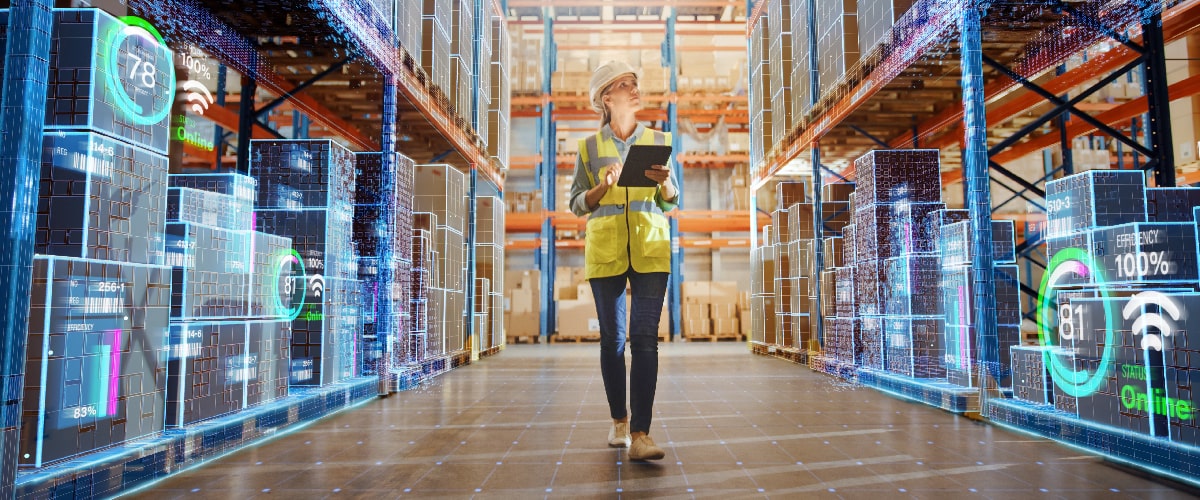 Web Content Viewer
Web Content Viewer
How Analytics and AI Play a Significant Role in Warehouse Management Today

The integration of artificial intelligence (AI) into many industries has led to incredible advancement, including within the warehousing sector. AI technologies have brought about a substantial transformation in traditional warehouse operations by providing creative solutions that improve overall efficiency and streamline processes. The warehouse industry has reached a turning point and warehouse management is entering a period of never-before-seen innovation and efficiency.
AI is recognized for generating advantages for warehouses, including decreased expenses and enhanced customer contentment - the pinnacles of superior warehouse management. In the upcoming years, robotics utilization in warehouse environments will progress even more. Businesses currently have strong incentives to implement AI technologies, ranging from mobile devices with AI-generated transaction processing to enhanced cybersecurity measures and worker safety. Stronger operations and increased efficiency also provide significant incentives.
Although there is some level of fear and uncertainty concerning AI adoption in some areas, today we will look at a few of the benefits to AI adoption in the warehouse.
The Impact of Automation and Robotics
Robotics powered by AI will keep expanding in the warehousing industry. Order fulfillment is accelerated by warehouse robots' ability to move swiftly through the warehouse, selecting the most efficient paths. These robots recognize products and direct them to the appropriate bins and warehouse slots using computer vision systems in conjunction with conveyor belts and mechanized arms. Businesses that adopt these technologies stand to gain increased productivity, lower expenses, and reliable quality control.
Worker Safety in the Warehouse
Beyond efficiency, robotics has been a substantial enabler of worker health and safety in the warehouse. In addition to saving businesses throughput times, robots can safely move large, heavy packages, thereby safeguarding human workers. Robots can also help businesses shorten delivery times and protect workers by not requiring workers to enter situations where their safety could be compromised, either in physically demanding or dangerous areas or HAZMAT situations.
Supply Chains Optimization through Predictive Analytics:
AI can predict needs by analyzing data to recognize trends, and even incorporate outside data to foresee interruptions in the supply chain. AI-powered predictive analytics maximize supply chain responsiveness and efficiency by predicting changes in demand, allowing you to reduce associated risks. Order picking, inventory management, and other warehousing operations can be optimized with these results.
Proper Configuration Within the Warehouse
A poorly configured warehouse will slow throughput or even lead to increased picking errors. AI can review product movement and make recommendations for optimal product placement so that warehouses can utilize their cubic space better to optimize efficiencies and increase throughput.
Cybersecurity and AI
Since AI can identify, evaluate, and react to malicious attacks more quickly than human intelligence, it has emerged as a potent weapon in the fight against cyber threats. AI is being used to understand and look for threats, help businesses understand those threats, and help identify what can be done about them. AI measures are most effective when implemented in conjunction with human elements (called augmented AI). In the digital age, this is essential to maintaining compliance and security. Before incorporating AI into business processes including the warehouse, employees should be ready to handle the technology's intricacies and make use of its advantages without jeopardizing the organization's cybersecurity.
Going Mobile
Tech companies may deploy a warehouse management solution that leverages mobile devices that are designed to make transaction processing in a warehouse lighter, easier, and faster. Voice assistants, text prediction, facial recognition, and other AI-powered capabilities are becoming more standard, improving user experiences. Not only are AI-powered mobile apps very handy, but they can also adjust to user behavior, which makes them extremely user-friendly.
Businesses can leverage the enhanced touchscreen display on the mobile device, for instance, to present data in a clear, concise, easy-to-read format that reduces training time and speeds up operations. Most people use a mobile device, so this allows companies to bring warehouse employees up to speed faster, and quickly train seasonal workers when needed. Intuitive technology also drives efficiency, allowing companies to process more transactions with fewer people.
One of the most revolutionary technological breakthroughs of the last century is what we are experiencing now. For the first time since the Industrial Revolution or even the tech boom of the 2000s, technology is upending fundamental societal roles. There is little question regarding AI's broad influence on how work and communication will be conducted in warehouses in the future. Indeed, many believe that AI will be the most significant business advantage of the future.
Gina Parry
National Account Manager
National Account Manager
Comments
By using this site you agree to our Privacy Policy and our Terms of Use.
120 Comac Street
Ronkonkoma, NY 11779
Ronkonkoma, NY 11779
 | Vormittag Associates, Inc. ©2025 |
| Vormittag Associates, Inc. ©2025 |